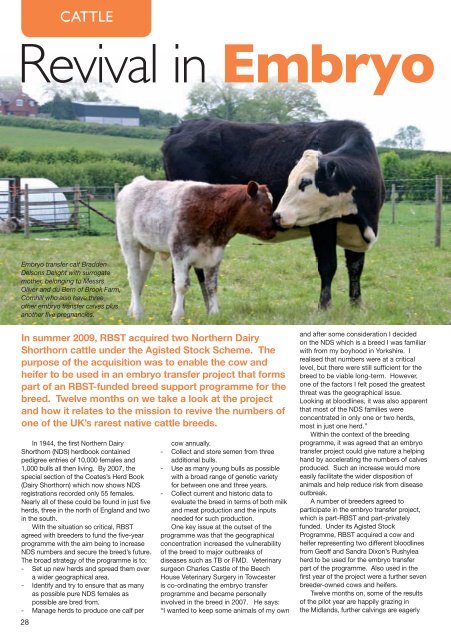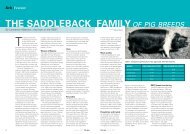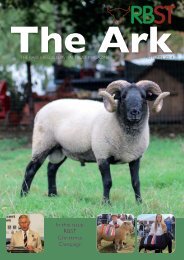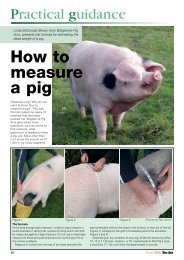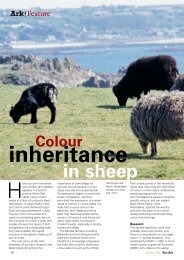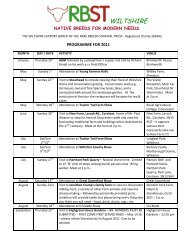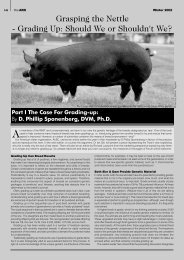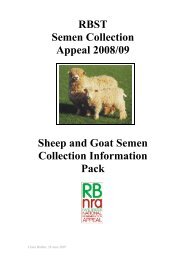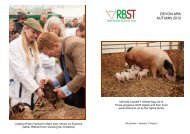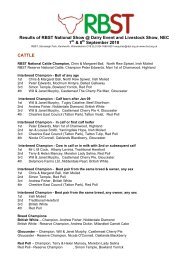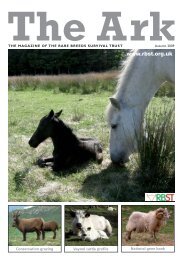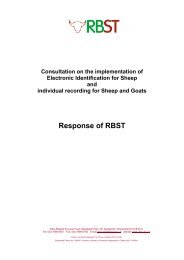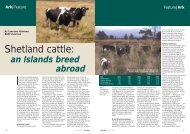You also want an ePaper? Increase the reach of your titles
YUMPU automatically turns print PDFs into web optimized ePapers that Google loves.
CATTLE<br />
Revival in Embryo<br />
Embryo transfer calf Bradden<br />
Delsons Delight with surrogate<br />
mother, belonging to Messrs<br />
Oliver and du Bern of Brook Farm,<br />
Cornhill who also have three<br />
other embryo transfer calves plus<br />
another five pregnancies.<br />
In summer 2009, RBST acquired two Northern Dairy<br />
Shorthorn cattle under the Agisted Stock Scheme. The<br />
purpose of the acquisition was to enable the cow and<br />
heifer to be used in an embryo transfer project that forms<br />
part of an RBST-funded breed support programme for the<br />
breed. Twelve months on we take a look at the project<br />
and how it relates to the mission to revive the numbers of<br />
one of the UK’s rarest native cattle breeds.<br />
In 1944, the first Northern Dairy<br />
Shorthorn (NDS) herdbook contained<br />
pedigree entries of 10,000 females and<br />
1,000 bulls all then living. By 2007, the<br />
special section of the Coates’s Herd Book<br />
(Dairy Shorthorn) which now shows NDS<br />
registrations recorded only 55 females.<br />
Nearly all of these could be found in just five<br />
herds, three in the north of England and two<br />
in the south.<br />
With the situation so critical, RBST<br />
agreed with breeders to fund the five-year<br />
programme with the aim being to increase<br />
NDS numbers and secure the breed’s future.<br />
The broad strategy of the programme is to:<br />
- Set up new herds and spread them over<br />
a wider geographical area.<br />
- Identify and try to ensure that as many<br />
as possible pure NDS females as<br />
possible are bred from.<br />
- Manage herds to produce one calf per<br />
28<br />
cow annually.<br />
- Collect and store semen from three<br />
additional bulls.<br />
- Use as many young bulls as possible<br />
with a broad range of genetic variety<br />
for between one and three years.<br />
- Collect current and historic data to<br />
evaluate the breed in terms of both milk<br />
and meat production and the inputs<br />
needed for such production.<br />
One key issue at the outset of the<br />
programme was that the geographical<br />
concentration increased the vulnerability<br />
of the breed to major outbreaks of<br />
diseases such as TB or FMD. Veterinary<br />
surgeon Charles Castle of the Beech<br />
House Veterinary Surgery in Towcester<br />
is co-ordinating the embryo transfer<br />
programme and became personally<br />
involved in the breed in 2007. He says:<br />
“I wanted to keep some animals of my own<br />
and after some consideration I decided<br />
on the NDS which is a breed I was familiar<br />
with from my boyhood in Yorkshire. I<br />
realised that numbers were at a critical<br />
level, but there were still sufficient for the<br />
breed to be viable long-term. However,<br />
one of the factors I felt posed the greatest<br />
threat was the geographical issue.<br />
Looking at bloodlines, it was also apparent<br />
that most of the NDS families were<br />
concentrated in only one or two herds,<br />
most in just one herd.”<br />
Within the context of the breeding<br />
programme, it was agreed that an embryo<br />
transfer project could give nature a helping<br />
hand by accelerating the numbers of calves<br />
produced. Such an increase would more<br />
easily facilitate the wider disposition of<br />
animals and help reduce risk from disease<br />
outbreak.<br />
A number of breeders agreed to<br />
participate in the embryo transfer project,<br />
which is part-RBST and part-privately<br />
funded. Under its Agisted Stock<br />
Programme, RBST acquired a cow and<br />
heifer representing two different bloodlines<br />
from Geoff and Sandra Dixon’s Rushylea<br />
herd to be used for the embryo transfer<br />
part of the programme. Also used in the<br />
first year of the project were a further seven<br />
breeder-owned cows and heifers.<br />
Twelve months on, some of the results<br />
of the pilot year are happily grazing in<br />
the Midlands, further calvings are eagerly


